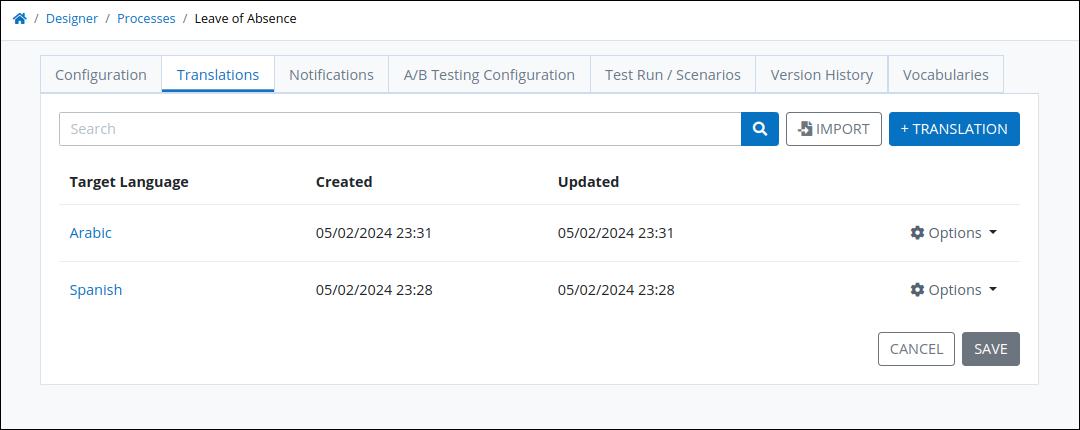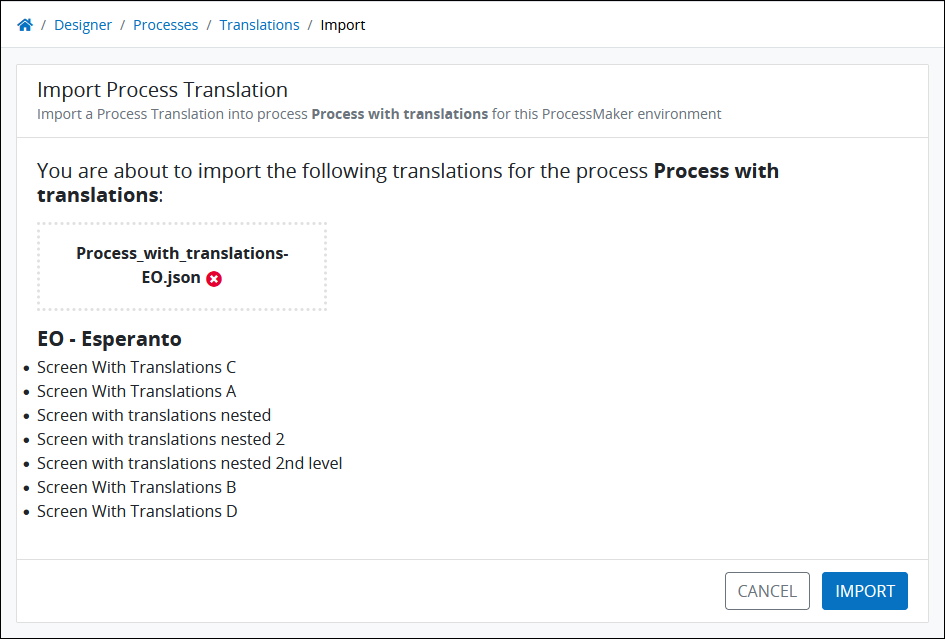Import a language translation for the Screens used in a Process.
Import Language Translations for Screens Used in a Process
Import language translations for Screen used in a Process that have been exported from the same ProcessMaker Platform version or later. In doing so, the selected Process imports all Screens used in that Process only in the language from which those Screens were previously exported for this Process. Screens cannot be imported for other than the selected Process.
Permissions
Your user account or group membership must have the following permissions to import Screen translations for a Process unless your user account has the Make this user a Super Admin setting selected:
Processes: Import Processes
Processes: View Processes
See the Processes permissions or ask your Administrator for assistance.
Use caution when importing language translations for a Process in which its Screens are partially translated because existing translations may be overwritten upon import. Importing translations use the following protocol:
If the importing language translation contains a string that corresponds with a Screen control's translated string, the importing string overwrites the existing string for that control. For example, if the Screen control contains a translation for
Full Name, the importing translation overwrites the existing translation.If the importing language translation contains a string that corresponds with a Screen control not containing a translated string, the importing string imports to that control's translation. For example, if there is no translation for
Full Name, the importing translation becomes the control's translation.If the importing language translation contains a string that corresponds with a Screen control in which its value is
null, then the importing string does not import for that control's translation.
Follow these steps to import translated Screens for a selected Process:
Configure general settings for the Process in which to import its Screen translations. The Configuration tab displays.
Click the Translations tab. Languages to which the Process's Screens have been translated display.

Translations tab that displays language translations of Screens for a selected Process Click the Import button. The Import Process Translation page displays.

Import Process Translation page to import one language translation of a Process's Screens Click the Select file from computer link to locate the language translation of a Process's Screens to import. Translations have the
.jsonfile extension. ProcessMaker Platform evaluates the file to import. If the language translations was not exported from the same or later ProcessMaker Platform version as being imported, that language translation may not import.The Import Process Translation page displays the Process's Screens previously translated to the language shown in the summary.

Import Process Translation page displays the Process's Screens previously translated to the language in the summary Click the Import button. The following message displays: The Process Translation was imported successfully. The Translations tab displays to indicate that the language translation imported correctly unless that language translation already existed in this ProcessMaker Platform instance.
Export Language Translations for Screens Used in a Process
Export the Process's Screen translations for one selected language to which those Screens are translated. This function does not export all translations for all languages to which the Process's Screens have been translated.
Permissions
Your user account or group membership must have the following permissions to export Screen translations for a Process unless your user account has the Make this user a Super Admin setting selected:
Processes: Export Processes
Processes: View Processes
See the Processes permissions or ask your Administrator for assistance.
Follow these steps to export the language translations for the Screens used in a Process:
Configure general settings for the Process in which to export its Screen translations. The Configuration tab displays.
Click the Translations tab. Languages to which the Process's Screens have been translated display.

Translations tab that displays language translations of Screens for a selected Process Click the
 menu for a language translation to export, and then select the Export Translation option. The Export Process Translation page displays.
menu for a language translation to export, and then select the Export Translation option. The Export Process Translation page displays. 
Preparing to export the Screens translated to a selected language for a Process Click Export.
By default, ProcessMaker Platform exports the language translation using the Process name except spaces in the name are replaced with underscores (
_), suffixed with the language name. The file has the file extension.json. Rename the default file name if necessary, though do not change the file extension. As a best practice, specify in the file name that this is an exported language translation for that Process's Screens to distinguish it from other exported assets.Specify a directory location to save the file. ProcessMaker Platform exports the
.jsonfile to your local computer. The following message displays when the language translation exports successfully: The translation for the process was exported.